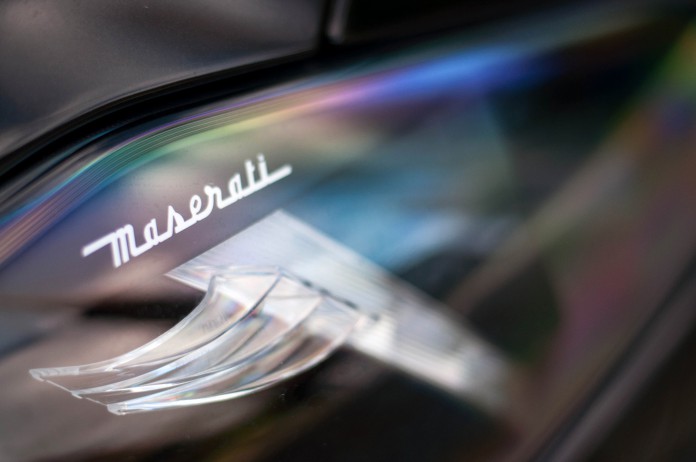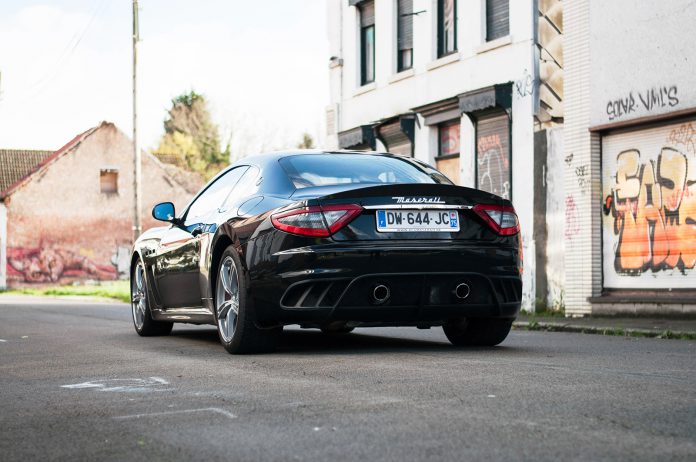The Maserati GranTurismo range must be one of the longest model line in sports cars world. Back in 2007 we saw the very first GranTurismo and a few weeks ago we had the chance to drive the latest and most sporting version in the range, a 2015 GranTurismo MC Stradale. This particular model made it’s world debut at the 2013 Geneva Motor Show, three years after the first generation MC Stradale.
All current Maserati models are built in a new plant in Turin, while the MC Stradale is still being built at the historic factory in Viale Ciro Menotti in Modena. That of course isn’t the biggest difference with the previous MC Stradale, but the standard four seat conversion is one of a few, and we honestly have to say that Maserati did a very good job here, but more about that later. The MC Stradale comes with the well-known 4.7-liter aspirated V8 engine that can be found in the GranTurismo Sport range and produces 460 hp. Combined with an MC Race Shift 6-speed electro actuated gearbox, the engine ensures outstanding performance with a top speed of 303 km/h.
Performance wise, the MC Stradale creates utmost driving pleasure with its raw exhaust sounds and its planted feel on the road. Extra features on our test car included semi-slick tires, that we are sure are fantastic in the dry, but certainly were not at their best on wet road conditions we experienced. Furthermore, safety was guaranteed by the Brembo carbon ceramic brake disks.
In keeping with Maserati’s principles and the current environmental liabilities, the latest GranTurismo MC Stradale focuses more on reducing fuel consumption and emissions. Our average test consumption was +15 liter per 100 km, but that is as a result of the many short distance journeys we covered. This is more than acceptable for a car in this category.
 Just like the previous two seater version, the new four seater MC Stradale takes its inspiration from the racing version that competes in the Maserati Trofeo World Series, offering the perfect combination of sportiness, luxury and elegance, comfort and style, functionality and dynamism that can now be enjoyed by four people.
Just like the previous two seater version, the new four seater MC Stradale takes its inspiration from the racing version that competes in the Maserati Trofeo World Series, offering the perfect combination of sportiness, luxury and elegance, comfort and style, functionality and dynamism that can now be enjoyed by four people.
On the exterior there are several new aesthetic features reflecting a clear racing edge. They include a new carbon fiber bonnet which frames an important central air intake that creates high-speed downforce and improved cooling. Thanks to the use of an all new carbon fiber bonnet the four-seat MC Stradale retains almost the same dry weight as its predecessor (1,700 kg).

With the two rear exhausts and the new forged 20″ alloy rims you’ll get a perfectly looking and sounding sports car. Once you get in the car you will find more luxury combined with a lot of performance. With the 3 different settings for the gearbox and exhaust system you can drive the throaty V8 without waking up the entire neighbourhood. When driving in normal mode the car is not much louder than a standard Maserati, the visuals, of course, grab more attention than usual. When putting the car in sports mode the valves in the exhaust will open when exceeding the 3,400 rpm mark. When driving in race mode the exhaust system opens from 700 rpm. This mode definitely gives the most driving pleasure, as long as you are covering short distances. Once on the motorway the sport mode gives more than enough response in power, throttle and sound. When cruising long distances we recommend using the normal mode.
 The 460 hp coming from the 4.7-liter V8 engine in the nose of the car means it sprints from standstill to 100 km/h in just 4.5 seconds and will only stop at its top speed of 303 km/h. It makes us wonder what the car would be capable of is Maserati tuned the engine to +500 hp, most probably in the next iteration of the Gran Turismo is presented, and that won’t be seen earlier than 2020.
The 460 hp coming from the 4.7-liter V8 engine in the nose of the car means it sprints from standstill to 100 km/h in just 4.5 seconds and will only stop at its top speed of 303 km/h. It makes us wonder what the car would be capable of is Maserati tuned the engine to +500 hp, most probably in the next iteration of the Gran Turismo is presented, and that won’t be seen earlier than 2020.
The gearbox is just superb. The GranTurismo MC Stradale utilizes the six-speed electro-actuated MC Race Shift transaxle gearbox. The layout here not only helps the MC Stradale to retain an ideal 48.52 front-to-rear weight distribution, but also incorporates the brilliant MC Race gear shifting strategy that allows it to change to higher gears in just 60 milliseconds, that is 5 times faster than a blink of an eye. The transaxle layout means that it sits in the same housing as the asymmetrical limited slip differential.
Another nice detail, directly drawn from its racing experiences, is that the gearbox also offers sequential downshifting. The driver then simply has to hold the downshift paddle in when braking and that will allow the car to change to sequentially lower gears until the paddle is released.
All of this dynamic performance the GranTurismo MC Stradale generates is backed up by some of the most powerful brakes in production, with the big carbon-ceramic brake discs at all four wheels of the car. The brake master cylinder has a diameter of 27 mm to add consistent power and to deliver a shorter pedal stroke than the standard GranTurismo. The front brake package has 380mm x 34mm brake discs and six-piston calipers, while the rear has 360mm x 32mm discs and four-piston calipers.
 Last but not least the MC Stradale comes with four 20-inch alloy wheels that are lighter than the standard wheels, while Pirelli has developed its PZero Corsa tyres with sizes of 255/35 ZR20 at the front and 259/35 ZR20 at the rear, specifically to deliver more grip. As previously mentioned, it was difficult to judge the performance of the track oriented tyres given the wet conditions we faced.
Last but not least the MC Stradale comes with four 20-inch alloy wheels that are lighter than the standard wheels, while Pirelli has developed its PZero Corsa tyres with sizes of 255/35 ZR20 at the front and 259/35 ZR20 at the rear, specifically to deliver more grip. As previously mentioned, it was difficult to judge the performance of the track oriented tyres given the wet conditions we faced.
When taking a closer look at the driving experience we can simply say that the MC Stradale has us smiling from ear to ear during the 4 days we had to experience it. From the very first seconds we were in the car, when leaving the dealership in Ghent, to the very last seconds we had to get out when we came back at the dealership we were buzzing with excitement. To conclude, the MC Stradale has evolved significantly compared to the first generation car we drove back in 2010. It feels and looks like the car has grown up.











































